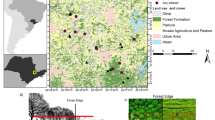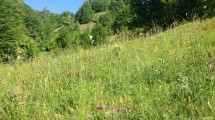Abstract
Edges between forest and non-forest habitats often have significant effects on forest microclimate and resource availability, with corresponding effects on species composition and abundance. Exotic species are often increased in abundance near forest edges. This increase in abundance could be either because of the increase in resource availability near edges, or because of increased dispersal into forest edges. We measured species composition and a set of geospatial variables on transects at 66 edges in the North Carolina Piedmont in an attempt to distinguish between these two factors. Mantel tests show that species composition is significantly different in forest edges than in the forest interior, but that this effect only penetrates about 5 m into the forest. Indicator species analysis finds several species that are indicative of edge communities, including trumpet vine (Campsis radicans), two drought-tolerant oak species (Quercus stellata and Q. falcata), a serviceberry (Amelanchier arboreum), and a common exotic species, tree-of-heaven (Ailanthus altissima). Poisson regression techniques showed that in both the seedling and tree strata of the forest, exotic species increased in abundance on flat sites with a high potential seed source. Mapping predicted exotic species abundance onto the landscape. We find that large-scale variation in exotic species abundance is due mostly to variation in potential seed sources, while small-scale variation relates more to edaphic factors. Our results stress that both dispersal and environmental filters are important for determining exotic species abundance, but potentially the filters operate at different spatial scales.
Similar content being viewed by others
References
Aizen MA and Feinsinger P (1994). Forest fragmentation, pollination and plant reproduction in a chaco dry forest, Argentina. Ecology 75: 330–351
Ashe WW (1897). Forest of North Carolina. In: Pinchot, G and Ashe, WW (eds) Timber trees and forest of North Carolina. North Carolina Geological Survey, pp. Winston, North Carolina
Bain GL (1966). Geology and ground-water in the Durham area, North Carolina. United State Geological Survey. Raleigh, NC
Beers TW, Dress PE and Wensel LC (1966). Aspect transformation in site productivity research. Journal of Forestry 64: 691–692
Beven KJ and Kirkby MJ (1979). A physically based, variable contributing area model of basin hydrology. Hydrologic Science Bulletin 24: 43–69
Billings WD (1938). The structure and development of old field shortleaf pine stands and certain associated physical properties of the soil. Ecological Monographs 8: 436–499
Bowers MA and Dooley JL (1999). A controlled, hierarchical study of habitat fragmentation: responses at the individual, patch and landscape scale. Landscape Ecology 14: 381–389
Braun EL (1950). Decidious Forests of Eastern North America. Hafner Publishing Company, New York
Brown RL and Peet RK (2003). Diversity and Invasibility of Southern Appalachian Plant Communities. Ecology 84: 32–39
Cadenasso ML and Pickett STA (2001). Effect of edge structure on the flux of species into forest interiors. Conservation Biology 15: 91–97
Cain ML, Milligan BG and Strand AE (2000). Long-distance seed dispersal in plant populations. American Journal of Botany 87: 1217–1227
Caley MJ, Buckley KA and Jones GP (2001). Separating ecological effects of habitat fragmentation, degradation, and loss on coral commensals. Ecology 82: 3435–3448
Chen JC, Saunders SC, Crow TR, Naiman RJ, Brosofske KD, Mroz GD, Brookshire BL and Franklin JF (1999). Microclimate in forest ecosystem and landscape ecology. Bioscience 49: 288–297
Christensen NL and Peet RK (1984). Convergence during secondary forest succession. Journal of Ecology 72: 25–36
Clark JS, Silman M, Kern R, Macklin E and HilleRisLambers J (1999). Seed dispersal near and far: Patterns accross temperate and tropical forests. Ecology 80: 1475–1494
Davies-Colley RJ and Payne GW (2000). Microclimate gradients across a forest edge. New Zealand Journal of Ecology 24: 111–121
Dietz EJ (1983). Permutation tests for association between two distance matrices. Systematic Zoology 32: 21–26
Dufrêne M and Legendre P (1997). Species assemblages and indicator species: the need for a flexible asymmetrical approach. Ecological Monographs 61: 53–73
Endler Da (1982). Quantitative matrix comparisons in ecological and evolutionary investigations. Journal of Theoretical Biology 99: 777–795
Euskirchen ES, Chen J and Bi R (2001). Effects of edges on plant communities in a managed landscape in Northern Wisconsin. Forest Ecology and Management 148: 93–108
Fagan WE, Cantrell RS and Cosner C (1999). How habitat edges change species interactions. American Naturalist 153: 165–182
Fagan WF, Lewis MA and Neubert MG (2002). Invasion theory and biological control. Ecology Letters 5: 148–157
Fahrig L (2002). Effect of habitat fragmentation on the extinction threshold: A synthesis. Ecological Applications 12: 346–353
Fahrig L (2003). Effects of habitat fragmentation on biodiversity. Annual review of ecology, evolution and systematics 34: 487–515
Forman RT and Deblinger RD (2000). The ecological road-effect zone of a Massachusetts (USA) Suburban Highway. Conservation Biology 14: 36–46
Gelbard JL and Belnap J (2003). Roads as conduits for exotic plant invasions in a semiarid landscape. Conservation Biology 17: 420–432
Hanski I (1998). Metapopulation dynamics. Nature 396: 41–49
Hanski I and Ovaskainen O (2000). The metapopulation capacity of a fragmented landscape. Nature 404: 755–758
Harris LD (1984). The Fragmented Forest: Island Biogeographic Theory and the Preservation of Biotic Diversity. University of Chicago Press, Chicago
Harrison S and Bruna E (1999). Habitat fragmentation and large-scale conservation: what do we know for sure. Ecography 22: 225–232
Hobbs RJ (2001). Synergisms among habitat fragmentation, livestock grazing and biotic invasions in southwestern Australia. Conservation Biology 15: 1522–1528
Hobbs RJ and Huenneke LF (1992). Disturbance, diversity and invasion – implications for conservations. Conservation Biology 6: 324–337
Keever C (1950). Causes of succession on old fields of the piedmont, North Carolina. Ecological Monographs 20: 230–250
Laurance WF (2002). Hyperdynamism in fragmented habitats. Journal of Vegetation Science 13: 595–602
Laurance WF and Cochrane MA (2001). Special section: Synergistic effects in fragmented landscapes. Conservation Biology 15: 1488–1489
Laurence WF, Lovejoy TE, Vasconcelos HL, Bruna EM, Didham RK, Stouffer PC, Gascon C, Bierregaard RO, Laurance SG and Sampaio E (2002). Ecosystem decay of Amazonian forest fragments: A 22-year investigation. Conservation Biology 16: 605–618
Legendre P and Legendre L (1998). Numerical Ecology.. Elsevier Science, Amsterdam
Lorimer CG, Chapman JW and Lambert WD (1994). Tall understory vegetation as a factor in the poor development of oak seedlings beneath mature stands. Journal of Ecology 82: 227–237
MacNally R and Bennett AF (1997). Species-specific predictions of the impact of habitat fragmentation: Local extinction of birds in the box-ironbark forests of Central Victoria, Australia. Biological Conservation 82: 147–155
Mantel N (1967). The detection of disease clustering and a generalized regression approach. Cancer Research 27: 209–220
McCune B and Grace JB (2002). Analysis of Ecological Communities. MJM Software, Gleneden Beach, Oregon
McDonald RI, Peet RK and Urban DL (2002). Environmental correlates of oak decline and red maple increase in the North Carolina Piedmont. Castanea 67: 84–95
McDonald RI and Urban DL (2004a). Forest edges and tree growth rates in the North Carolina Piedmont. Ecology 85: 2258–2265
McDonald RI and Urban DL (in press) Spatially varying rules of land-cover change: lessons from a case study. Journal of Landscape and Urban Planning
Moen J and Jonsson BG (2003). Edge effects on liverworts and lichens in forest patches in a mosaic of boreal forest and wetland. Conservation Biology 17: 380–388
Murcia C (1995). Edge effects in fragmented forests – implications for conservation. Trends in Ecology and Evolution 10: 58–62
(2003). RDU Climate Normals. North Carolina State University, Durham, NC
Norton DA, Hobbs RJ and Atkins L (1995). Fragmentation, disturbance and plant distribution: mistletoes in woodland remnants in the Western Australia wheatbelt. Conservation Biology 9: 426–438
Oosting HJ (1942). An ecological analysis of the plant communities of Piedmont, North Carolina. American Midland Naturalist 28: 1–126
Pauchard A and Alaback P (2004). Influence of elevation, land use and landscape context on patterns of alien plant invasions along roadsides in protected areas of South-Central Chile. Conservation Biology 18: 238–248
Peet RK and Christensen NL (1980). Succession: A population process. Vegetatio 43: 131–140
Ranney JW, Bruner MC and Levenson JB (1981). The importance of edge in the structure and dynamics of forest islands. In: Burgess, RL and Sharpe, DM (eds) Forest Island Dynamics in Man-dominated Landscapes, pp 67–92. Springer-Verlag, New York
Rheault H, Drapeau P, Bergeron Y and Esseen P (2003). Edge effects on epiphytic lichens in managed black spruce forests of eastern North America. Canadian Journal of Forest Research 33: 23–32
Riitters KH, Wickham JD, O’Neill RV, Jones KB, Smith ER, Coulston JW, Wade TG and Smith JH (2002). Fragmentation of continental United States forests. Ecosystems 5: 815–822
Saunders DA, Hobbs RJ and Margules CR (1991). Biological consequences of ecosystem fragmentation: a review. Conservation Biology 5: 18–32
Sharpe DM, Stearns FW, Burgess RL and Johnson WC (1981). Spatio-temporal patterns of forest ecosystems in man-dominated landscapes. In: Tjallingii, SP (eds) Perspectives in Landscape Ecology., pp 109–116. Pudoc, Wageningen
Simberloff D (1988). The contribution of population and community biology to conservation science. Annual Review of Ecology and Systematics 19: 473–511
Smouse PE, Long JC and Sokal RR (1986). Multiple regression and correlation extensions of the Mantel test of matrix correspondence. Systematic Zoology 35: 627–632
Trimble SW (1974). Man-induced soil erosion on the Southern Piedmont. Soil Conservation Society of America, Ankeny, Iowa
Watkins RZ, Chen JC, Pickens JB and Brosofske KD (2003). Effects of forest roads on understory plants in a managed hardwood landscape. Conservation Biology 17: 411–419
Weathers KC, Cadenasso ML and Pickett STA (2001). Forest edges as nutrient and pollutant concentrators: Potential synergisms between fragmentation, forest canopies, and the atmosphere. Conservation Biology 15: 1506–1514
Weiher E and Keddy PA (1995). Assembly rules, null models and trait dispersion – New questions front old patterns. Oikos 74: 159–164
With KA (2002). The landscape ecology of invasive spread. Conservation Biology 16: 1192–1203
Author information
Authors and Affiliations
Corresponding author
Rights and permissions
About this article
Cite this article
McDonald, R.I., Urban, D.L. Edge Effects on Species Composition and Exotic Species Abundance in the North Carolina Piedmont. Biol Invasions 8, 1049–1060 (2006). https://doi.org/10.1007/s10530-005-5227-5
Received:
Accepted:
Published:
Issue Date:
DOI: https://doi.org/10.1007/s10530-005-5227-5




